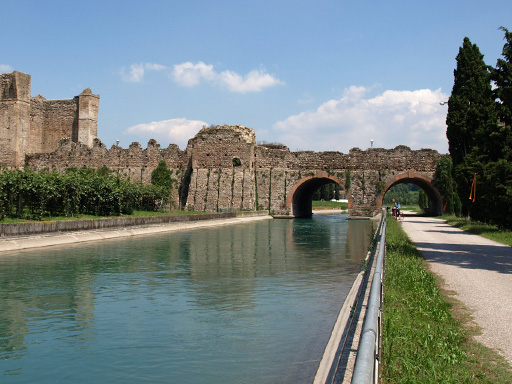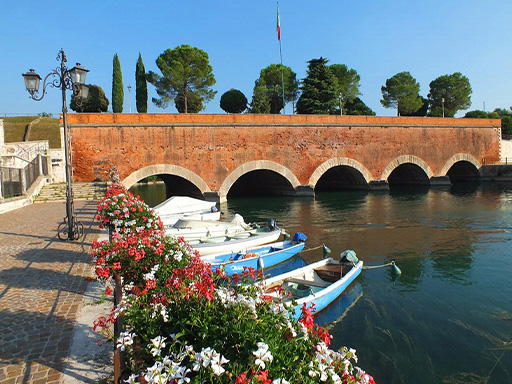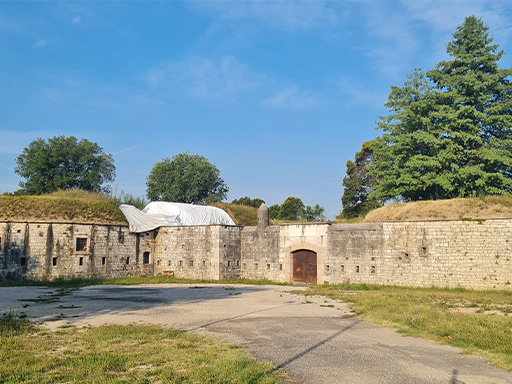MTB tour of intermediate difficulty. The route is 46 kilometres long and is recommended for cyclists with a moderate amount of training. It will take you to Lazise.
Comune: Peschiera del Garda
The advantage of this 38 km long route is the regional road that allows you to cycle around the entire lake. The route is all flat which leaves you enough time to admire the beautiful views of Garda Veneto.
A shared pedestrian and cycle route from Mantua to Peschiera del Garda, 40 km of backroads and cycle tracks to discover the charming hinterland of the Mincio Park, the Garda section of the Ciclovia del Sole (The Sun Route).
A circular route that starts from the city of Verona and follows the beautiful path along the artificial canals to arrive at Rivoli Veronese. After reaching the town centre, it descends to Lake Garda. The itinerary is linked to the Ciclovia del Sole (The Sun Cycle Route).
This route matches in parts the path of the Gran Fondo of Peschiera del Garda, modified in the initial part to avoid very busy roads. The trail is about 100 km long, but it is possible to shorten it by avoiding the climb towards Lumini, so that the distance covered is about 74 km.
The Verona section of the route, which is about 69 km long, crosses the municipalities of Peschiera del Garda, Castelnuovo del Garda, Lazise and Bardolino until it reaches Malcesine. It is a mix of a cycling route with the regional road. The sections that go along the lake are recommended for the unique views that only Lake Garda can offer.

Central hub for reaching the main tourist destinations of the lower Lake Garda area

A point of interest on the EuroVelo 7 or “The Sun Route”, Peschiera is the starting point for the enchanting Peschiera-Mantova Cycle Route of Mincio. Thanks to its location, it is a central junction for reaching the main tourist destinations of the lower Lake Garda area, taking advantage of the excellent cycle connections, cycling in the most beautiful natural park in Europe and with the precious possibility of using the ferry service, always carrying your bike. You can find all the information on cycle tourism at the Tourism Peschiera Infopoint just a few metres from the start of the Peschiera-Mantova cycle route, with ample and convenient free parking space and only five minutes from the railway station.
Helpful information
![]() Tourism Peschiera Infopoint, Piazzale Cesare Betteloni, Peschiera del Garda, VR, Italia
Tourism Peschiera Infopoint, Piazzale Cesare Betteloni, Peschiera del Garda, VR, Italia

The location of the Scaliger castle and the remains of the ancient Roman tower on the Via Gallica

Between 1500 B.C. and 600 B.C., the pile-dwelling village of Peschiera was the centre of the
culture of northern Italy and above all the bronze production hub.
It is said that during the Roman period, there was an imposing square tower there in Peschiera, 9m wide, 2.5m thick, at least 25/30m high and built of marble stone. The tower had a twin on the opposite side of the Mincio river, and a bridge connecting it with the mainland in Peschiera into so-called ‘double bridgehead’ fortification work. The military-strategic position on the Via Gallica, squeezed between the lake and the marshy plains, as the only transit passage between Veneto and Lombardy, made Peschiera the desired prize for many people over the centuries. Among them were the Veronese Scaliger family in the 1200s, the Milanese Sforza in the 1300s, the Venetians in the 1500s and the Austrians in the 1800s.
Helpful information
![]() Rocca Scaligera con torre romana, Peschiera del Garda, VR, Italia
Rocca Scaligera con torre romana, Peschiera del Garda, VR, Italia

Panoramic bridge over the Canale di Mezzo

The Ponte dei Voltoni recognisable by its characteristic five arches was built in 1556. The Venetian commissioner, Iacobo Gauro, whose tombstone on the facade of the house in Via Dante is still visible today, directed the building works immediately after the construction of the fortress. On leaving the bridge, passing under the arch nearest to the Piazza Ferdinando di Savoia, there was once a permanent fishing post there called ‘Pescarezzo’.
Those fishing posts were characteristic of Peschiera del Garda, known also in the Roman times and mentioned in the writings of Pliny the Elder. There is only one of those posts remaining today, the surviving witness to Lake Garda’s history. Recently restored, as memory and museum, today it can be seen from the Lungolago Bonomi, or, thanks to the service of the guided boat tours. Today, the Ponte dei Voltoni is one of the most striking images of the city, characteristic of Peschiera del Garda.
Helpful information
![]() Ponte dei Voltoni, Via Dante, Peschiera del Garda, VR, Italia
Ponte dei Voltoni, Via Dante, Peschiera del Garda, VR, Italia

An example of Austrian architecture built in the mid-19th century

The fort was built to withstand the enemy’s advances from the west, hence the shape of its western side that could absorb artillery fire. The east side, facing Peschiera, was not defended by earth ramparts, and the main wall was indefensible in the event of bombardment from the fortress. This way in case the enemy had taken the fort it could have been easily destroyed, rendering it unserviceable.
Ten artillery positions consisting of 6 cannons, 2 howitzers and 2 mortars were set up for defence.
The fort could accommodate a maximum of 106 men.
From the elevated artillery positions, it was possible to see Fort Cappuccini and Fort Laghetto, all the fortifications were in fact built in such a way that they could be visually controlled. The fort originally had no chimneys so as not to be visible to the enemy.
Helpful information
![]() Forte Papa, Via Milano, Peschiera del Garda, VR, Italia
Forte Papa, Via Milano, Peschiera del Garda, VR, Italia
